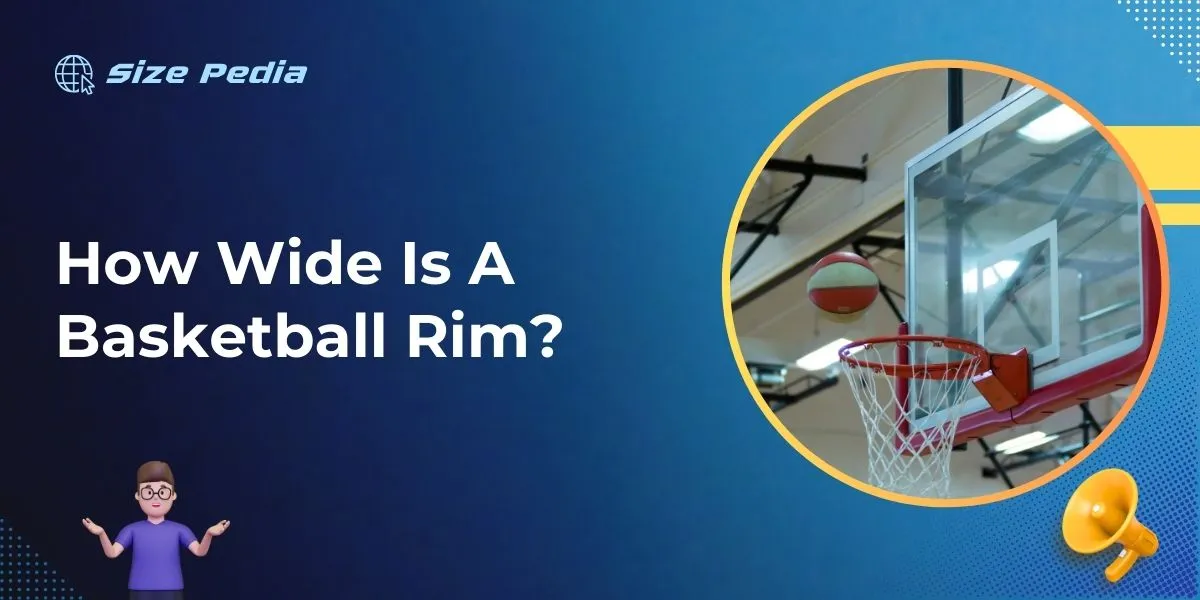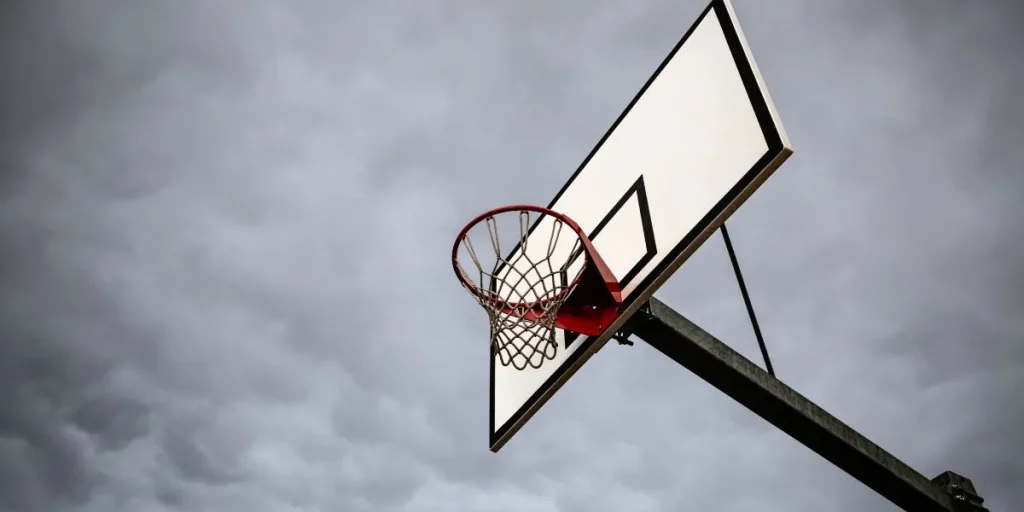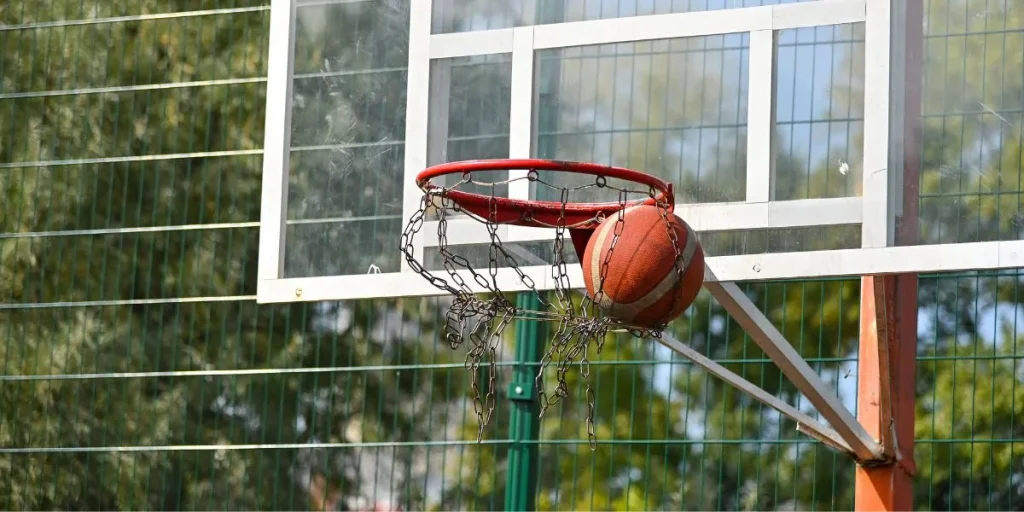A basketball rim measures 18 inches in diameter. This stands as a standard across all professional leagues.
Understanding the dimensions of the basketball rim is crucial for players at all levels, from amateurs to professionals.
The size of the rim directly affects the difficulty of scoring a basket and underpins the design of basketballs, which have a diameter of about 9.
5 inches to ensure a good fit. Knowing the rim’s width allows players to hone their shooting skills effectively.
It also influences the design of backboards and the spacing of court markings. The 18-inch rim, with its forgiving width, allows for captivating buzzer-beaters and dunking showcases that keep fans on the edge of their seats.
Coaches, players, and equipment manufacturers all rely on this key measurement to maintain consistency in the sport.

Official Dimensions Of A Hoop
The Official Dimensions of a Hoop play a crucial role in the game of basketball. Understanding these measurements ensures fairness and standardization across all levels of play.
Whether for professional leagues or a neighborhood game, the rim’s dimensions keep the sport consistent and competitive.
Breaking Down The Measurements
The basketball rim, often referred to as the “hoop,” is more than just a circular object. Its size and structure influence the game significantly. Let’s explore the precise measurements.
- Diameter: The rim’s diameter is 18 inches across.
- Thickness: Made of solid steel, the rim’s thickness measures 5/8 inch.
- Height: The hoop stands 10 feet off the ground, measured from the playing surface to the top of the rim.
Contrast With Other Sports
Evaluating basketball hoop dimensions against other sports reveals fascinating contrasts.
Each sport has its unique set of equipment measurements to ensure the game’s integrity and challenge.
| Sport | Equipment | Measurement |
|---|---|---|
| Tennis | Net Height | 3.5 feet |
| Volleyball | Net Height | 7 feet 4 1/4 inches |
| Soccer | Goal Width | 24 feet |
In comparison, the basketball rim’s diameter is much smaller, highlighting the skill required to score.
Material And Design Evolution

The evolution of basketball’s rim from simple beginnings to today’s high-tech design showcases a fascinating journey. This change has had a significant impact on the sport itself.
From Peach Baskets To Steel Rings
The basketball rim began as nothing more than a peach basket nailed to a ten-foot high track.
In these early days, the game paused each time a team scored. Someone had to retrieve the ball from the basket. James Naismith, the inventor of basketball, sought a better solution.
The peach baskets were replaced with metal hoops and a hammock-style net.
Innovation didn’t stop there. The hoops evolved from a closed bottom to an open-net design.
This allowed the ball to fall through seamlessly after a score, speeding up the gameplay.
Influence On The Game
Material changes to the rim have influenced basketball at every level. The original wooden backboards gave way to shatterproof glass.
This made the game more visual for spectators. The steel ring is now a standard 18 inches across, ensuring consistency in play worldwide.
- More durable materials have led to a faster, smoother game.
- The steel rims can take high-intensity play, enabling dunks.
- Spring-loaded rims help in reducing the chance of injuries.
Regulations Across Leagues
The diameter of a basketball rim is crucial to the game’s consistency and fairness. Leagues worldwide adhere to specific standards, ensuring players compete on a level playing field. These regulations span professional to youth levels.
Nba Standards
The National Basketball Association (NBA) has precise measurements.
- Rim diameter: exactly 18 inches.
- Steel material ensures durability.
- The rim’s inner circle allows the ball a snug fit.
The NBA’s strict guidelines promote a uniform gameplay experience.
Fiba Differences
The International Basketball Federation (FIBA) also adheres to the 18-inch standard. Despite similarities with the NBA, slight differences exist:
- Color contrast on backboard for visibility.
- Breakaway rims to reduce injury risk.
FIBA standards are designed for international play compatibility.
Youth And Amateur Guidelines
Youth and amateur leagues adjust regulations to suit different age groups.
- Rims at 10 feet high for consistency.
- Some leagues may reduce rim size for smaller balls.
These guidelines cater to developing skills and enjoyment for younger players.
Slam Dunk Physics

Let’s explore the thrilling science behind slamming a basketball into the hoop. The rim’s width plays a pivotal role in the game’s most exciting moments.
Strength And Precision Needed
Powerful jumps and careful aim define a slam dunk. Here’s a breakdown of the essentials:
- Vertical leap: To reach the rim, a player must jump high.
- Hand-eye coordination: Precision guides the ball through the hoop.
- Timing: Players sync their jump with their arm’s extension.
To score, a player’s hands must clear a 10-foot high rim. The rim has a consistent width of 18 inches across leagues.
This measurement ensures the ball fits through with little room to spare, demanding high accuracy from the player.
Impact On The Rim
Every slam dunk transmits significant force to the basketball rim. Here is how the rim handles the impact:
| Aspect | Impact Details |
|---|---|
| Rim Strength | Designed to withstand up to 230 pounds of force. |
| Bounce-back | Hinges provide flexibility, preventing breakage. |
| Material | Constructed of steel, ensures durability against dunks. |
The rim’s construction must accommodate the force of dunking without bending or breaking.
Breakaway rims are now common, which helps in absorbing the shock and protecting both player and equipment.
A successful dunk requires just the right cocktail of player exertion and rim resilience, making it a spectacle of human athleticism and engineering genius.
Maintaining The Integrity Of The Rim
Maintaining the Integrity of the Rim is crucial for a fair and enjoyable basketball game. The rim, sitting precisely 18 inches in width, must remain in perfect condition to ensure each shot’s accuracy is consistent.
This means regular checks and updates are as important as the rules of the game itself. Keeping the rim sturdy and true allows players to shoot with confidence and rely on the equipment to perform its part on the court.
Let’s dive into the essentials of rim care.
Regular Inspections And Replacements
Consistent rim checks are the cornerstone of basketball maintenance. Professionals and school teams often:
- Examine the rim before and after games.
- Look for bent areas or damaged parts.
- Ensure the net is properly attached and free from tears.
Replacing a rim is necessary to prevent compromised shots. To replace the rim, courts follow these steps:
- Unbolt the existing rim from the backboard.
- Set the new rim in place.
- Bolt the new rim securely onto the backboard.
By regularly inspecting and replacing worn rims, gameplay remains fair and enjoyable for everyone involved.
Technological Innovations In Design
Breakthroughs in technology keep basketball equipment cutting-edge. For rims, this entails:
| Feature | Benefit |
|---|---|
| Spring-Loaded Mechanisms | Allows the rim to flex under pressure to prevent snapping. |
| Durable Materials | Increases longevity and reduces the need for frequent replacements. |
| Weather-Resistant Coating | Protects outdoor rims from rust and other environmental damage. |
These advancements ensure that basketball rims can withstand intense play, serve reliably over the years and provide consistent game day experiences for all players.
Achievements In Rim Testing
Basketball rim testing has made leaps and bounds over the years. Researchers and engineers work tirelessly to ensure players can slam, swing, and score without a second thought about the rim’s integrity.
As they push the boundaries of physics and materials science, the achievements in rim testing continue to amaze both athletes and fans alike.
Record-breaking Dunks
Rims have witnessed many jaw-dropping dunks through the ages. Each dunk adds to the history of achievements in rim testing. Let’s look at some stellar slam-dunk records:
- Highest Dunk: A rim soars at 10 feet, but professional dunkers leap amazing heights for that slam.
- Most Dunks in a Minute: Testers push the rim to its limits, racking up dunks to check for efficiency.
- Longest Dunk: From the free-throw line, athletes fly to the hoop, testing the rim’s distance tolerance.
Rim Durability Under Stress
How does a rim withstand intense gameplay? Rigid testing protocols ensure that rims durable. Manufacturers simulate real-life conditions:
- Weight Drop Tests: They drop heavy weights on the rims to mimic powerful dunks.
- Hang Time Analysis: They measure how long the rim sustains a player hanging from it.
- Vibration Resistance: They check how the rim copes with the shock from rapid rebounds.
| Test Type | Purpose | Result |
|---|---|---|
| Weight Drop | Mimic powerful dunks | Measure rim’s bending |
| Hang Time | Test sustained weight | Check rim endurance |
| Vibration | Assess shock absorption | Determine stability |
FAQs About the Width of a Basketball Rim
How Wide Is A Nba Basketball Rim?
An NBA basketball rim measures 18 inches in diameter. This standard size ensures consistency across all professional basketball hoops.
How Much Bigger Is The Rim Than The Basketball?
A basketball rim is typically 18 inches in diameter, while a standard basketball is about 9. 5 inches in diameter, making the rim approximately 4. 5 inches wider than the ball.
Can Two Basketballs Fit In A Rim?
No, two basketballs cannot fit in a rim simultaneously. A standard rim’s diameter is too small to accommodate both at once.
What Size Is A Women’s Basketball Rim?
A women’s basketball rim measures 18 inches in diameter, identical to the men’s rim size. It’s universally standard in the sport.
Conclusion
Understanding the dimensions of a basketball rim is crucial for players at every level. Precisely 18 inches across, the rim’s uniform width ensures fair play globally.
Mastering your shot within this standard helps hone precision skills. Whether a budding amateur or a seasoned pro, focusing on this can lead to game-changing improvements.
Keep practicing, and aim true!
Resources:
https://www.vba.vic.gov.au/consumers/guides/basketball-rings
https://www.cambridgema.gov/steam/steamathomeactivities/Basketball-Hoop
